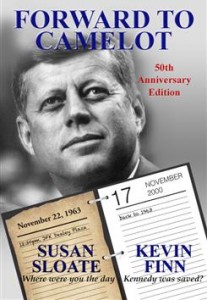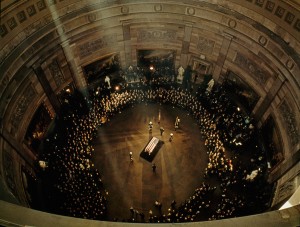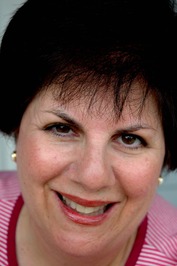 Today’s guest post is from Susan Sloate, one of the authors of today’s featured review book, Forward to Camelot: 50th Anniversary Edition. Her topic is the continued fascination with the Kennedy Assassination, an event that took place over 50 years ago.
Today’s guest post is from Susan Sloate, one of the authors of today’s featured review book, Forward to Camelot: 50th Anniversary Edition. Her topic is the continued fascination with the Kennedy Assassination, an event that took place over 50 years ago.
Like the author, I was also in the first grade when JFK was assassinated. Unlike most children my age, I was home that week, sick with tonsillitis, so I don’t have that clear-cut memory of a school announcement. But the world still changed that day.
And without that one shattering moment, other equally heart-breaking events probably might not have taken place; the 1968 assassinations of Martin Luther King, Jr. and Robert F. Kennedy.
Many authors have gone back and imagined the different course that history would have taken if JFK had lived, because those moments in Dallas feel like a turning point that overshadows history.
Why Write about the Kennedy Assassination?
By Susan Sloate
Why write about an event that took six seconds to occur, and that is, in the words of one reviewer, ‘probably the most written-about crime in history’? Why add yet another book to the cartloads of books appearing on the 50th anniversary? Why, in other words, bring it up yet again? What does it matter?
You don’t realize, especially when you’re very young, when an event cuts straight through your heart. I realized on 9/11 that something enormous and heart-breaking was occurring—and as I wept I knew I would remember it always, and forever after, it would hurt. But I was at that point in my 40’s and a mother of two small children. The impact—on them and me—was so clear. And I’d been through national tragedies before.
I didn’t realize the impact when I heard the announcement in my first-grade classroom, though I never forgot it. I don’t remember having much reaction at all. Two years before, when my nursery-school bus driver drove us home, he entertained us with the story of Lincoln’s assassination. God knows why you’d tell this to four-year-olds, but I was very interested and filed it away in my mind. (And grew up to write a book about Lincoln—everything is potential fodder!)
So when the news came from our principal, Mr. Kahan, that President Kennedy had been shot and killed in Dallas that afternoon, I don’t remember any of my classmates reacting as their older brothers and sisters did—with shock and grief and anger. We were children. We didn’t realize what it all meant. (And in my case, having heard about Lincoln so recently, I just figured that was how presidents got out of office.) I remember my twenty-something teacher announcing at once that we were going to lay aside our work and instead, each write a letter to Mrs. Kennedy, telling her how sorry we were for her family. It was what you did in 1963. Mrs. Kennedy, apparently, received millions of these notes from all over the world, in a massive outpouring of grief.
 I do remember looking at my parents’ copies of Life and Look magazines. I remember in particular the aerial photo of the President’s casket, draped with the flag, as it lay in state at the Capitol. Its imprint sank deep into my memory. The photo strip of the Zapruder film reproduced in Life—I saw that too, and it touched something deep inside me.
I do remember looking at my parents’ copies of Life and Look magazines. I remember in particular the aerial photo of the President’s casket, draped with the flag, as it lay in state at the Capitol. Its imprint sank deep into my memory. The photo strip of the Zapruder film reproduced in Life—I saw that too, and it touched something deep inside me.
Several years later—I was twelve or so—I would come home from school to find my mother baking bread. The clearest image of that is the log-shaped loaf she would set on the counter to rise, covering it with a clean kitchen towel—thin colored stripes on a white background. Every time I saw it, it reminded me again of that flag-draped casket.
I grew up and read a few books about the assassination and found them interesting. But I didn’t realize how much the event had clutched me to its heart until 1992, when I saw Oliver Stone’s brilliant film JFK.
I took a long meditative walk and asked myself, with all the people who knew it was going to happen, why didn’t the right people find out in time to stop it? And I began to imagine what I would do if suddenly, I could travel miraculously back to that vanished world and interfere with the history that was.
With writers, it’s just a step from daydreaming to planning—and before I knew it, I was sitting down to type some pages. None of them remain in the finished novel, which became Forward to Camelot. It would be years before I’d pull in my friend Kevin Finn as my co-author, and more years before we’d even figure out a way through the maze of information. But I knew that what I was going to do was fix what went wrong in November 1963. I was going to make things turn out differently for the President and the country.
The urge to ‘fix it’, to make the bad things go away, is a motivation for many writers, I think. It’s certainly mine: to take something bad and using the alchemy of structure, plot and character, turn it into something beautiful.
So why write again about the most written-about crime in history? Because this time, through a brave heroine and against impossible odds, Kevin and I unraveled the threads of history and set them right. And when I hear from readers, “How I wish this was true”, I know that our mission succeeded, in their dreams and in ours.
 ABOUT SUSAN SLOATE
ABOUT SUSAN SLOATESUSAN SLOATE is the author of 20 previous books, including the recent bestseller Stealing Fire and Realizing You (with Ron Doades), for which she invented a new genre: the self-help novel. The original 2003 edition of Forward to Camelot became a #6 Amazon bestseller, took honors in three literary competitions and was optioned by a Hollywood company for film production.
Susan has also written young-adult fiction and non-fiction, including the children’s biography Ray Charles: Find Another Way!, which won the silver medal in the 2007 Children’s Moonbeam Awards. Mysteries Unwrapped: The Secrets of Alcatraz led to her 2009 appearance on the TV series MysteryQuest on The History Channel. Amelia Earhart: Challenging the Skies is a perennial young-adult Amazon bestseller. She has also been a sportswriter and a screenwriter, managed two recent political campaigns and founded an author’s festival in her hometown outside Charleston, SC.

